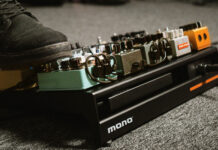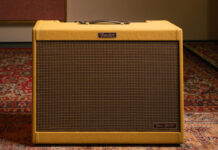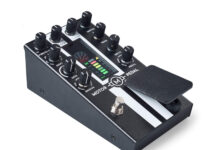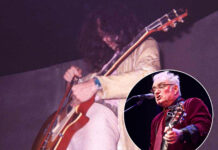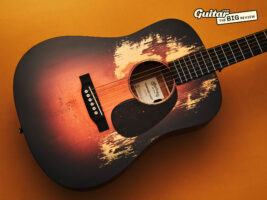
Martin Junior Series D Jr E StreetLegend review: “this guitar feels Junior in name only”
£899/$899, martinguitar.com
When it first arrived nearly a decade ago, Martin’s Dreadnought Jr was a real leap into the unknown for America’s oldest acoustic guitar brand. It was a smaller guitar that felt, well, big – with a scaled down version of Martin’s most famous body shape, it had the proportions and look of a classic acoustic guitar, and an impressively loud and layered sound to go with it.
READ MORE: Martin D-X2E Billy Strings review – “you certainly don’t need to be a bluegrass phenom to appreciate its charms”
The Dreadnought Jr was a bona fide hit, bringing dread aesthetics and tonality to those with smaller frames or who wanted something more compact to take it on the road. It was such a hit that the Junior Series soon became a thing, with basses and 000 models added to the fold in the following years.
Now however, on the back of redesigning their hugely popular X Series entry-level guitars last year, it’s the turn of the Juniors – and this time they’re trying to make these small guitars feel bigger than ever.
Image: Adam Gasson
Martin D Jr E StreetLegend – what is it?
The most striking difference between the new Dreadnought Jr and its forebear is an issue of scale. While the original guitars opted for a very compact 24-inch scale length, the new guitars up the ante to a ‘full-size’ 24.9 inches on their 14-fret necks. Now, that’s still some way short of a real Dreadnought’s usual 25.4-inch scale, but it’s on par with what you’d expect from some 000 and 00 guitars.
While this might not be an X Series guitar, it’s still made in Martin’s Mexican facility and like those models the Junior guitars feature playability-enhancing upgrades to the select hardwood neck, including bevelled fingerboard edges and ‘optimized’ string spacing.
You also get the same all-solid body woods that made the original Junior Series so well-liked – in this case you’ll find a spruce top paired with sapele back and sides. And there’s also the addition of Martin’s E1 electronics system to the package, meaning you can plug this in should you so desire.
Image: Adam Gasson
The biggest departure for this particular Dreadnought Jr however, is in the looks department. While the original D Jrs were available in either classic natural or more recently a StreetMaster worn sunburst, this guitar adds Martin’s hugely polarising StreetLegend faux-relic’d option to the range.
Ever since Martin debuted the StreetLegend concept with the premium D-18 model a few years ago, guitarists have been divided about it. Effectively, Martin uses an advanced printer to ‘print’ the wear pattern of a real Martin guitar onto a brand new guitar’s top.
That original StreetLegend pattern (which is a dead ringer for ‘Grandpa’ – Kurt Cobain’s D-18 that probably not coincidentally lives in Martin’s museum in Nazareth) was on a natural-finished guitar… here it’s been applied to a sunburst. I guess there’s no point spending an extra $200 on a finish if you’re not going to draw attention to it, right? Regardless, it’s probably the most eye-catching finish Martin has ever put on a standard-line production guitar from the Mexico factory.
Image: Adam Gasson
Martin D Jr E StreetLegend – build quality and playability
The impressive thing that the Dreadnought Junior does, just like its forebear, is to not immediately look or feel like a smaller guitar when you pull it out of its supplied padded softshell gigbag.
Its looks and dimensions are ‘right’ and not so much of a departure that you’d feel like Ed Sheeran should you strap it on and play out with it. This is in part because it’s not that much of a downsize – 360mm (14.2 inches) wide and 112mm (4.41 inches) deep as opposed to the full-size dread being 397mm (15.6 inches) by 124mm (4.88 inches).
That inch or so definitely helps it feel a little more comfortable played seated however, and the playability is further enhanced by the new scale length – you really get the sense that this is a proper, real, full-sized Martin guitar.
In terms of playability, I personally found the action a little high out of the box, but it is still perfectly playable as long as you don’t want something overly slinky. This is further enhanced by the nicely rolled fingerboard edging, string spacing that threads the needle for comfortable fretting and chord work.
In terms of the visuals, there’s no doubt that the StreetLegend burst definitely looks more impressive at a distance than it does up close. You can really tell that it’s been printed on when you’re sat playing it, and that illusion breaking is only enhanced by the fact that the back and sides are not only un-aged, but don’t have a burst/paint on them at all. It all feels a bit disconnected aesthetically, and I can’t say I’m in love with it – I certainly wouldn’t pay an extra $200 (almost a third of the cost of the natural version) to get it.
I understand why Martin wanted to go big on the ‘look at me’ effect of the StreetLegend… but I can’t help wonder if they’d have sold a lot more of them if they’d kept a natural finish instead of the burst – it certainly would have been less jarring with the back, sides and neck.
Image: Adam Gasson
Martin D Jr E StreetLegend – sounds
The killer hook for the original Dreadnought Junior was its sound, and the way that it condensed so much of the classic Martin dread tonality into a more compact body. Obviously, you’re not going to get the same booming projection as you would a full-sized dreadnought here – that’s physics – but it’s a seriously impressive effort.
The sound is well balanced and warm, with the low-end softly permeating the high-end sparkle. There’s a lot of midrange to contend with here though, which can get a little overwhelming if you’re doing a lot of heavy strumming.
Tuning stability and intonation on the new neck was impressive and rock solid – the new open-gear tuning machines feeling really reassuring as you drop into DADGAD or other altered tunings.
The Martin E1 pickup and preamp system is a relatively simple affair, but that’s no bad thing – with a tuner, volume and tone controls, and a phase reverse switch for reducing feedback and increasing bass response. As an all-solid guitar, you also know that it’s only going to sound better with age, too, as the woods dry out over time.
The tuner has a useful muting function to ensure you don’t inflict the sound of a mid-gig tuneup on your audience and while the sounds aren’t going to win any awards, they do a nice job of replicating the instrument’s natural tonal profile.
Image: Adam Gasson
Martin D Jr E StreetLegend – should I buy one?
The mid-price acoustic guitar market is one of the most brutal and competitive out there, so you have to take your hat off to Martin in some respects for doing something to try and stand out from the natural-finished pack with the StreetLegend finish option.
You’re always going to pay an extra premium for the Martin headstock logo at this price point, and there are clearly many guitars out there with similar specs and performance for a fair chunk less money than even the basic Dreadnought Junior. They don’t say ‘CF Martin & Co’ on the peghead though, and we’re all kidding ourselves if we don’t think that matters.
Putting an extra 200 bucks on the base price to get an artificially aged top though? That is a different gravy, and one that I’m personally not at all sold on.
The new Dreadnought Junior is undeniably an upgrade on the previous version, one that plays and sounds fantastic, and remains an accessible first rung on the ‘solid wood Martin’ ladder that sets itself apart from the X Series. For me though, I’ll be taking the natural version – I imagine most of you reading this will too.
Image: Adam Gasson
Martin D Jr E StreetLegend – alternatives
The vast majority of players will be more than happy with the natural Dreadnought Jr ($699) though if you want a less unsubtle take on the artificial ageing idea, the StreetMaster version is $799. If you want an affordable all-solid dreadnought that’s also got some big brand associations, the Fender Paramount PD-220E ($699) is hard to beat, while if you’re not too bothered about all-solid woods, the Gretsch Jim Dandy Dread ($189) is a remarkably good value guitar with old-school vibes.
The post Martin Junior Series D Jr E StreetLegend review: “this guitar feels Junior in name only” appeared first on Guitar.com | All Things Guitar.
Source: www.guitar-bass.net


